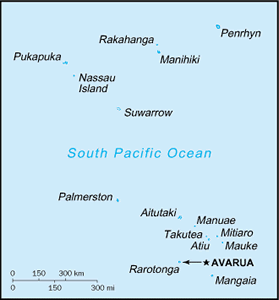The Geography of Cook Islands
The Geography of Cook Islands
Cook Islander Geography
Location: Oceania, group of islands in the South Pacific Ocean, about half way between Hawaii and New Zealand
Geographic coordinates: 21 14 S, 159 46 W
Map references: Oceania
Area: total: 236.7 sq km land: 236.7 sq km water: 0 sq km
Area - comparative: 1.3 times the size of Washington, DC
Land boundaries: 0 km
Coastline: 120 km
Maritime claims: territorial sea: 12 nm exclusive economic zone: 200 nm continental shelf: 200 nm or to the edge of the continental margin
Climate: tropical oceanic; moderated by trade winds; a dry season from April to November and a more humid season from December to March
Terrain: low coral atolls in north; volcanic, hilly islands in south
Elevation extremes: lowest point: Pacific Ocean 0 m highest point: Te Manga 652 m
Natural resources: NEGL
Land use: arable land: 16.67% permanent crops: 8.33% other: 75% (2005)
Irrigated land: NA
Natural hazards: typhoons (November to March)
Environment - current issues: NA
Environment - international agreements: party to: Biodiversity, Climate Change, Climate Change-Kyoto Protocol, Desertification, Hazardous Wastes, Law of the Sea, Ozone Layer Protection
Geography - note: the northern Cook Islands are seven low-lying, sparsely populated, coral atolls; the southern Cook Islands, where most of the population lives, consist of eight elevated, fertile, volcanic isles, including the largest, Rarotonga, at 67 sq km


